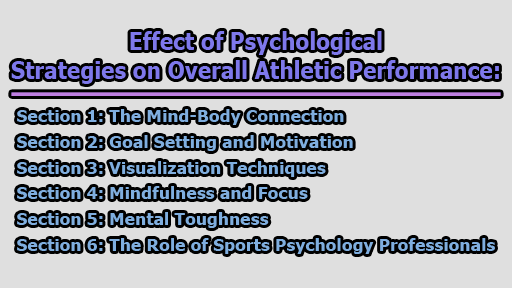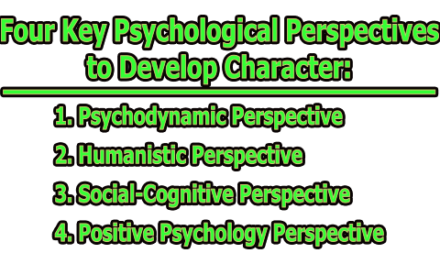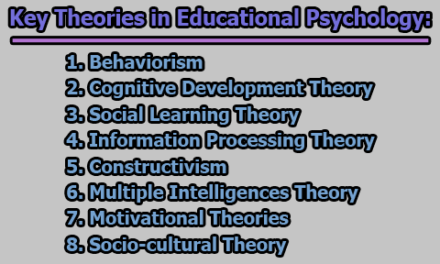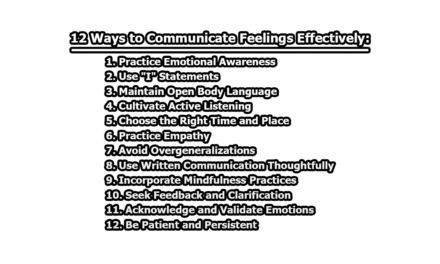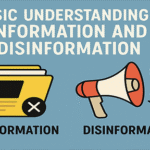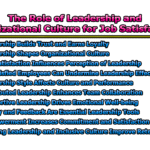Effect of Psychological Strategies on Overall Athletic Performance:
In the realm of sports, the focus has traditionally been on physical prowess, technical skills, and tactical acumen. However, the significance of mental strength and psychological strategies in shaping an athlete’s performance is increasingly gaining recognition. In this article, we will explore the multifaceted effect of psychological strategies on overall athletic performance, exploring various aspects such as mental resilience, goal setting, visualization, and mindfulness.
Section 1: The Mind-Body Connection:
The mind-body connection in sports is a dynamic and intricate interplay between psychological and physiological factors that significantly influence athletic performance. This connection underscores the realization that mental and physical aspects are not isolated entities but coalesce to shape an athlete’s overall experience and success in their respective sport.
1.1 Understanding the Psychological Aspect of Sports:
1.1.1 Mental Resilience and its Role in Facing Challenges: Mental resilience, defined as the ability to bounce back from adversity and adapt to challenging situations, is a cornerstone of high-performance sports psychology (Fletcher & Sarkar, 2012). Athletes endowed with mental resilience exhibit a capacity to maintain focus, composure, and performance quality under pressure (Gucciardi et al., 2017). This psychological trait extends beyond mere endurance; it encapsulates the proactive engagement with challenges, fostering a growth mindset that views setbacks as opportunities for development (Connaughton et al., 2008).
Research suggests that mental resilience is not a fixed trait but can be cultivated through targeted interventions, positively impacting an athlete’s response to stressors and enhancing their ability to navigate the complexities of competitive sports (Fletcher & Sarkar, 2012).
1.1.2 The Impact of Stress and Anxiety on Athletic Performance: Stress and anxiety are inherent components of sports competition, influencing athletes both mentally and physically (Craft et al., 2003). The relationship between stress and performance is nuanced, with moderate stress levels potentially enhancing performance by sharpening focus and arousal, while excessive stress and anxiety can lead to suboptimal outcomes (Craft et al., 2003).
Understanding the physiological response to stress is essential for athletes and coaches. Elevated cortisol levels, triggered by stress, can negatively impact cognitive functions, decision-making processes, and overall athletic performance (Hanton et al., 2005). Effective stress management techniques, such as mindfulness and relaxation, are integral to mitigating these negative effects and optimizing an athlete’s mental state for peak performance (Gardner & Moore, 2006).
1.1.3 The Relationship Between Mindset and Physical Capabilities: The mindset, or one’s beliefs about their abilities, plays a pivotal role in shaping an athlete’s approach to training and competition (Dweck, 2006). Dweck distinguishes between a fixed mindset, where individuals believe their abilities are innate and unchangeable, and a growth mindset, where individuals perceive their capabilities as malleable and subject to improvement through effort and learning.
Athletes with a growth mindset tend to embrace challenges, persist in the face of setbacks, and view effort as a path to mastery (Claro et al., 2016). This mindset not only fosters a positive attitude towards training but also influences an athlete’s motivation and resilience in the face of adversity, contributing to enhanced physical capabilities over time.
1.2 The Body’s Response to Psychological Factors:
1.2.1 The Role of Stress Hormones in Performance: The physiological response to stress involves the activation of the hypothalamic-pituitary-adrenal (HPA) axis, leading to the release of stress hormones, particularly cortisol (Mastorakos & Ilias, 2003). Cortisol, in moderate levels, serves to enhance alertness and preparedness for action, contributing to optimal performance during competition (Rimmele et al., 2007). However, chronic elevation of cortisol levels due to prolonged stress can lead to fatigue, impaired recovery, and decreased immune function, negatively impacting overall athletic performance (Halson, 2014).
Understanding the delicate balance of stress hormone release is crucial for athletes and coaches. Strategies to manage stress effectively, such as incorporating recovery periods and mindfulness practices, are essential for maintaining this balance and optimizing an athlete’s physical readiness for competition (Mastorakos & Ilias, 2003).
1.2.2 How Positive Psychological Strategies can Enhance Physical Recovery: Positive psychological strategies play a crucial role in enhancing the physical recovery process after intense training or competition (Hammond & Gialloreto, 2011). The psychological state of an athlete influences the recovery phase, with a positive mindset contributing to more effective recuperation (Kolt & Andersen, 2019).
Engaging in positive self-talk, setting realistic recovery goals, and maintaining a constructive mindset can impact the release of endorphins and neurotransmitters associated with relaxation and well-being (Kolt & Andersen, 2019). Additionally, adopting mindfulness and relaxation techniques has been shown to reduce muscle tension, improve sleep quality, and enhance overall physical recovery (Baltzell et al., 2014).
1.2.3 Integrating Mental and Physical Training for Holistic Development: Holistic athlete development requires the seamless integration of mental and physical training components (Gould et al., 2002). A comprehensive training program should address not only physical fitness but also the psychological skills essential for optimal performance.
Mental skills training, including visualization, goal setting, and stress management, should be embedded in the overall training regimen to foster a more resilient and well-rounded athlete (Vealey, 2007). Recognizing the interconnectedness of mental and physical dimensions ensures that athletes are equipped not only with the necessary physical capabilities but also with the mental fortitude to navigate the challenges inherent in competitive sports.
Section 2: Goal Setting and Motivation:
Goal setting and motivation are integral components of sports psychology, playing an essential role in shaping athletes’ aspirations, commitment, and ultimately, their performance outcomes.
2.1 Importance of Goal Setting in Sports:
2.1.1 Short-term vs. Long-term Goals: Goal setting in sports involves establishing both short-term and long-term objectives that contribute to an athlete’s overall development and success (Locke & Latham, 2002). Short-term goals provide immediate direction and feedback, aiding in skill acquisition and performance improvement, while long-term goals give athletes a sense of purpose and vision for their athletic journey (Weinberg & Gould, 2014).
Effective goal setting follows the SMART criteria, ensuring that goals are Specific, Measurable, Achievable, Relevant, and Time-bound (Locke & Latham, 2002). This systematic approach enhances goal clarity, making it easier for athletes to track progress and stay motivated (Burton, Weinberg, & Yukelson, 1998).
2.1.2 Goal-Setting Models Used by Elite Athletes: Elite athletes often employ sophisticated goal-setting models to maximize their performance. One such model is the process-oriented goals model, where the focus is on continuous improvement and mastering specific aspects of performance rather than solely on outcome-oriented goals (Burton et al., 1998). This approach helps athletes concentrate on factors within their control, fostering a mindset conducive to sustained motivation and success (Weinberg & Gould, 2014).
Additionally, the 4C model (Commitment, Challenge, Control, and Confidence) emphasizes the importance of setting challenging yet realistic goals that enhance an athlete’s commitment, self-efficacy, and overall performance (Burton et al., 1998).
2.2 Motivational Factors:
2.2.1 Intrinsic vs. Extrinsic Motivation: Motivation is a driving force in sports, influencing an athlete’s commitment, effort, and persistence. Intrinsic motivation stems from internal factors such as personal enjoyment, a sense of accomplishment, or a genuine interest in the sport. Extrinsic motivation, on the other hand, arises from external factors like rewards, recognition, or social approval (Deci & Ryan, 2000).
While both forms of motivation can coexist, intrinsic motivation is often associated with greater long-term commitment and enjoyment in sports, fostering a sustainable passion for training and competition (Vallerand, 1997).
2.2.2 The Impact of Motivation on Training Consistency: Consistent training is a cornerstone of athletic success, and motivation plays a pivotal role in maintaining this consistency. Self-determination theory posits that autonomy, competence, and relatedness are key psychological needs that, when satisfied, enhance intrinsic motivation and promote sustained effort. Athletes who feel a sense of autonomy in their training, perceive themselves as competent, and experience a connection with others are more likely to stay motivated over the long term (Deci & Ryan, 2000).
2.2.3 Strategies to Maintain Motivation During Challenging Times: Maintaining motivation during challenging periods is crucial for athletes facing setbacks or periods of low performance. Goal reevaluation, where athletes adjust their goals based on changing circumstances, can help maintain motivation by creating realistic and attainable objectives (Weinberg & Gould, 2014). Additionally, social support from coaches, teammates, and family members can provide the encouragement and reinforcement needed to navigate challenges and sustain motivation (Deci & Ryan, 2000).
Section 3: Visualization Techniques:
Visualization, also known as mental imagery or mental rehearsal, is a powerful cognitive technique employed in sports psychology to enhance performance, skill acquisition, and overall athlete well-being.
3.1 The Power of Mental Imagery:
3.1.1 Understanding the Concept of Visualization: Visualization involves creating mental images or scenarios to simulate or re-create specific aspects of athletic performance (Morris et al., 2005). Athletes mentally rehearse movements, strategies, and scenarios relevant to their sport, effectively engaging the same neural pathways as physical practice (Jeannerod, 1994). This process aids in skill development, decision-making, and performance optimization.
Research indicates that mental imagery is not merely a cognitive process; it has a physiological impact on the neuromuscular system, contributing to improved motor learning and skill execution (Guillot, Collet, Nguyen, Malouin, Richards, & Doyon, 2009).
3.1.2 Guided Imagery and Performance Enhancement: Guided imagery involves the use of scripted or guided scenarios designed to evoke specific sensory experiences and emotions relevant to sports performance (Smith, Holmes, Whitemore, Collins, & Devonport, 2001). Athletes engage in guided imagery sessions to mentally prepare for competition, manage stress, and enhance their overall performance.
Studies have shown that guided imagery can positively influence various performance-related factors, including self-confidence, concentration, and emotional regulation (Smith et al., 2001). Athletes who incorporate guided imagery into their training routines report increased self-efficacy and a heightened sense of control over their performance outcomes (Holmes & Collins, 2001).
3.1.3 Incorporating Visualization into Training Routines: Visualization is most effective when seamlessly integrated into an athlete’s regular training routine (Cumming & Williams, 2012). This integration involves incorporating mental imagery sessions into pre-practice or pre-competition rituals, allowing athletes to create a mental blueprint for success.
Athletes can use visualization to rehearse specific skills, tactical strategies, or entire performances, fostering a sense of familiarity and confidence in their abilities (Cumming & Williams, 2012). The consistency of incorporating visualization into training routines contributes to the development of a mental routine that complements physical training, ultimately enhancing overall performance.
3.2 Guided Imagery and Performance Enhancement:
3.2.1 How Guided Imagery Influences Muscle Memory: Guided imagery has a profound impact on the development and enhancement of muscle memory, a crucial component of sports performance (Cumming & Williams, 2012). When athletes vividly visualize themselves executing precise movements or techniques, the brain activates the same neural pathways involved in physical execution (Mulder, Hochstenbach, Van Heuvelen, & den Otter, 2007).
Repetition through mental imagery strengthens the neural connections associated with motor skills, contributing to improved muscle memory and coordination (Guillot et al., 2009). This phenomenon has been observed across various sports, highlighting the potential of guided imagery as a tool for refining motor skills and enhancing performance consistency.
3.2.2 Real-Life Examples of Athletes Using Visualization Successfully: Numerous elite athletes attribute their success, in part, to the consistent use of visualization techniques. For example, Michael Phelps, the most decorated Olympian of all time, acknowledged using visualization to mentally rehearse every detail of his races, from the start to the finish (Gibson, 2008). Phelps’s use of mental imagery exemplifies how visualization can be harnessed to create a mental roadmap for success, reinforcing confidence and optimal performance.
Similarly, tennis legend Serena Williams has spoken about her use of visualization to mentally simulate match scenarios, envisioning herself executing precise shots and strategic plays (Travis & Gervais, 2018). These real-life examples underscore the practical application and impact of visualization in the training and preparation of elite athletes.
3.2.3 Combining Visualization with Physical Practice for Optimal Results: The synergy between mental imagery and physical practice is key to unlocking the full potential of visualization techniques (Morris et al., 2005). Athletes who combine regular visualization sessions with dedicated physical training experience a comprehensive enhancement in skill acquisition and performance outcomes.
Research suggests that the integration of mental and physical practice is particularly effective for tasks requiring precision and fine motor skills (Jackson, Lafleur, Malouin, Richards, & Doyon, 2001). By aligning mental rehearsal with physical execution, athletes can optimize the learning process, refine their technique, and bolster their confidence in executing complex movements.
Section 4: Mindfulness and Focus:
Mindfulness, rooted in ancient contemplative practices, has gained prominence in sports psychology for its transformative impact on athletes’ focus, concentration, and overall mental well-being.
4.1 Mindfulness in Sports:
4.1.1 The Concept of Mindfulness and its Relevance in Athletics: Mindfulness involves cultivating present-moment awareness and acceptance without judgment (Kabat-Zinn, 2003). In the context of sports, mindfulness refers to the ability of athletes to fully engage in their athletic endeavors, remaining attuned to their thoughts, emotions, and bodily sensations during training and competition (Gardner & Moore, 2004).
Mindfulness in sports is not about eliminating distractions but rather about acknowledging them without being consumed by them. By fostering a non-judgmental awareness of the present moment, athletes can develop a heightened sense of focus and concentration (Gardner & Moore, 2004).
4.1.2 The Impact of Mindfulness on Concentration and Focus: Research indicates that mindfulness training positively influences attentional focus and concentration in athletes (Bernier, Thienot, Codron, & Fournier, 2009). Athletes who engage in mindfulness practices report improved attentional control, reduced mind-wandering, and enhanced ability to maintain focus under pressure (Gardner & Moore, 2004).
Mindfulness enables athletes to cultivate a ‘flow’ state, characterized by deep concentration and effortless performance (Csikszentmihalyi, 1990). By directing attention to the present moment, athletes can better regulate their thoughts and emotions, leading to heightened focus and a more optimal state for performance.
4.1.3 Mindfulness-Based Interventions for Performance Improvement: Mindfulness-based interventions, such as Mindfulness-Based Stress Reduction (MBSR) and Mindfulness-Based Cognitive Therapy (MBCT), have been adapted for use in sports settings to enhance athletes’ mental resilience and overall well-being (Gardner & Moore, 2004; Kabat-Zinn, 2003).
These interventions typically involve mindfulness training through guided meditation, body scan exercises, and mindful movement practices (Bernier et al., 2009). Athletes participating in mindfulness programs report reduced anxiety, improved emotional regulation, and an increased ability to stay focused during competition (Gardner & Moore, 2004).
4.2 Techniques for Enhancing Concentration:
4.2.1 Attentional Focus Strategies: Mindfulness enhances attentional focus through the development of specific attentional strategies. One such strategy is ‘single-pointed attention,’ where athletes concentrate on a specific aspect of their performance, such as their breath, a specific movement, or a focal point in their field of vision (Bernier et al., 2009).
By training the mind to sustain attention on a chosen point, athletes can reduce distractions, enhance concentration, and promote a state of heightened awareness (Gardner & Moore, 2004). This attentional focus strategy is particularly beneficial during high-pressure situations, helping athletes stay ‘in the moment’ and perform optimally.
4.2.2 Mindful Breathing and its Impact on Performance: Mindful breathing, a fundamental aspect of mindfulness practice, is a technique that involves bringing conscious attention to the breath (Kabat-Zinn, 2003). Athletes can use mindful breathing as a tool to anchor their focus, especially in stressful or distracting situations (Bernier et al., 2009).
Research suggests that incorporating mindful breathing into pre-competition routines can contribute to a calm and focused mental state, preparing athletes for optimal performance (Gardner & Moore, 2004). This simple yet powerful technique serves as a readily accessible method for athletes to regulate arousal levels and maintain concentration.
4.2.3 Practical Applications of Mindfulness in Sports Training: The integration of mindfulness into sports training involves incorporating mindfulness practices into daily routines, both on and off the field (Bernier et al., 2009). Athletes can engage in short mindfulness sessions during warm-ups, cooldowns, or breaks between training segments.
Moreover, incorporating mindfulness into daily life outside of sports, such as through mindful eating or walking, can contribute to an overall sense of presence and awareness that carries over into athletic endeavors (Gardner & Moore, 2004). This holistic approach fosters a continuous state of mindfulness, allowing athletes to reap the cognitive and emotional benefits in various aspects of their lives.
Section 5: Mental Toughness:
Mental toughness is a psychological construct that plays a pivotal role in an athlete’s ability to persevere, thrive under pressure, and overcome adversity. It encompasses a set of attributes, attitudes, and coping mechanisms that enable athletes to perform at their best despite challenging circumstances.
5.1 Defining Mental Toughness:
5.1.1 Components of Mental Toughness: Mental toughness comprises several interconnected components, including resilience, focus, self-confidence, and the ability to manage stress (Gucciardi, Hanton, & Mallett, 2012). Resilience involves bouncing back from setbacks, maintaining composure under pressure, and adapting to changing circumstances (Jones et al., 2007). Focus refers to the capacity to concentrate on relevant cues and disregard distractions during performance (Gucciardi et al., 2012). Self-confidence is the belief in one’s abilities and the capacity to perform under pressure (Gucciardi et al., 2012).
5.1.2 Resilience in the Face of Adversity: At the core of mental toughness is resilience, the ability to cope with and bounce back from challenging situations (Gucciardi et al., 2012). Resilient athletes view setbacks not as failures but as opportunities for growth and learning (Fletcher & Sarkar, 2012). They are more likely to maintain focus, perform consistently, and demonstrate perseverance in the face of adversity (Jones et al., 2007).
Athletes with high levels of mental toughness not only endure setbacks but use them as stepping stones to improve their skills and enhance their mental fortitude (Fletcher & Sarkar, 2012). This capacity for resilience contributes to sustained high-level performance over the course of an athlete’s career.
5.2 Strategies for Developing Mental Toughness:
5.2.1 Embracing Challenges as Opportunities for Growth: One key strategy for developing mental toughness is to cultivate a mindset that views challenges as opportunities for personal and athletic growth (Connaughton, Wadey, Hanton, & Jones, 2008). Athletes who embrace challenges are more likely to approach difficult situations with a positive attitude, viewing them as a chance to develop new skills, strategies, and mental resilience.
The growth mindset, as described by Dweck (2006), aligns with the idea of embracing challenges. Athletes who believe in their ability to improve through effort and persistence are more likely to navigate challenges with resilience and determination, fostering the development of mental toughness over time.
5.2.2 The Role of Self-Talk in Enhancing Mental Toughness: Self-talk, the internal dialogue an athlete engages in, plays a crucial role in shaping mental toughness (Hardy, Jones, & Gould, 1996). Positive self-talk involves using affirming and constructive statements, enhancing self-confidence and resilience. Athletes who engage in positive self-talk are better equipped to manage stress, maintain focus, and bounce back from setbacks (Hardy et al., 1996).
Conversely, negative self-talk can erode mental toughness, leading to self-doubt and increased susceptibility to pressure (Gucciardi et al., 2012). Teaching athletes to recognize and reframe negative self-talk into positive and constructive affirmations is a key aspect of mental toughness training.
5.2.3 Building a Resilient Mindset through Cognitive Restructuring: Cognitive restructuring involves identifying and challenging negative thought patterns, replacing them with more constructive and positive interpretations (Hanton, Fletcher, & Coughlan, 2005). By actively engaging in cognitive restructuring, athletes can reshape their perceptions of challenges and setbacks, promoting a resilient mindset (Hanton et al., 2005).
This strategy is particularly effective in situations where athletes may face perceived threats to their performance or encounter setbacks. By reframing negative thoughts and focusing on constructive interpretations, athletes can enhance their mental toughness and maintain a positive outlook even in challenging circumstances.
5.3 The Role of Sports Psychology Professionals:
5.3.1 The Emergence of Sports Psychology: The field of sports psychology has evolved significantly, with sports psychology professionals playing a pivotal role in enhancing mental toughness among athletes (Taylor & Wilson, 2005). Sports psychologists collaborate with athletes to develop tailored mental toughness training programs, incorporating evidence-based strategies to improve resilience, focus, and self-confidence.
The integration of sports psychology into athletic training regimens has become increasingly common, with many professional athletes recognizing the value of mental skills training for optimizing performance (Taylor & Wilson, 2005). The guidance and support provided by sports psychology professionals contribute to the holistic development of athletes, addressing both physical and psychological aspects of their performance.
5.3.2 Importance of Collaboration Between Coaches, Athletes, and Psychologists: Effective mental toughness training requires a collaborative approach involving coaches, athletes, and sports psychology professionals (Jones et al., 2007). Coaches play a crucial role in creating a supportive and challenging training environment that fosters the development of mental toughness (Connaughton et al., 2008).
Sports psychology professionals collaborate with coaches to identify specific mental toughness needs within the team or individual athletes. This collaboration enables the design of targeted interventions, ensuring that mental toughness training aligns with the unique demands of the sport and the individual characteristics of the athletes (Taylor & Wilson, 2005).
Section 6: The Role of Sports Psychology Professionals:
Sports psychology professionals play a critical role in enhancing the mental well-being, performance, and overall development of athletes. Their expertise extends beyond traditional coaching methods, delving into the intricate realm of psychological factors that influence athletic success.
6.1 The Evolution of Sports Psychology:
6.1.1 Historical Context: The field of sports psychology has witnessed significant evolution, transitioning from a relatively obscure discipline to an integral component of athlete development (Vealey & Chase, 2008). Early pioneers such as Coleman Griffith laid the foundation for the integration of psychological principles into sports coaching and training (Andersen, 2019).
As the importance of mental factors in sports performance became increasingly evident, the role of sports psychology professionals expanded to address a wide array of challenges, from enhancing focus and motivation to managing stress and building mental toughness (Andersen, 2019). Today, sports psychology is recognized as a vital component in optimizing athletic performance at all levels.
6.1.2 Interdisciplinary Collaboration: The collaboration between sports psychology professionals and other members of the athlete’s support team, including coaches, medical staff, and nutritionists, has become integral to comprehensive athlete care (Taylor & Wilson, 2005). This interdisciplinary approach recognizes that an athlete’s physical and psychological well-being are interconnected, and both dimensions must be addressed for optimal performance.
Sports psychology professionals work hand-in-hand with coaches to create an environment that fosters mental resilience, skill development, and overall psychological well-being (Taylor & Wilson, 2005). This collaborative effort ensures a holistic approach to athlete development that extends beyond the traditional focus on physical training.
6.2 Assessment and Intervention:
6.2.1 Individualized Assessment: Sports psychology professionals conduct thorough assessments to understand the unique psychological needs and challenges faced by athletes (Andersen, 2019). These assessments may include interviews, self-report measures, and observations, providing valuable insights into an athlete’s mental state, coping mechanisms, and performance-related psychological factors.
Individualized assessments allow sports psychology professionals to tailor interventions to the specific needs of each athlete, recognizing the diversity of mental skills required across different sports and individual personalities (Taylor & Wilson, 2005). This personalized approach ensures that interventions are not only effective but also resonate with the athlete’s goals and preferences.
6.2.2 Mental Skills Training: One of the primary roles of sports psychology professionals is to implement mental skills training programs aimed at enhancing various psychological aspects crucial for optimal athletic performance (Vealey & Chase, 2008). These programs often include interventions to improve concentration, manage stress, build confidence, and foster mental toughness.
Mental skills training incorporates evidence-based practices such as visualization, goal setting, relaxation techniques, and cognitive restructuring (Vealey & Chase, 2008). By equipping athletes with these tools, sports psychology professionals empower them to navigate the psychological challenges inherent in sports and perform at their best consistently.
6.3 Performance Enhancement:
6.3.1 Optimizing Focus and Concentration: Sports psychology professionals work closely with athletes to optimize their focus and concentration, essential components for success in sports (Taylor & Wilson, 2005). Through techniques such as attentional focus strategies, mindfulness, and imagery, athletes learn to maintain focus amidst distractions and perform at their peak during competition (Bernier et al., 2009).
Effective concentration strategies contribute to heightened situational awareness, improved decision-making, and enhanced overall performance (Gucciardi et al., 2012). Sports psychology professionals collaborate with athletes to develop personalized concentration routines and strategies that align with the demands of their specific sport.
6.3.2 Stress Management: The ability to manage stress is crucial for athletes facing the pressures of competition, training, and external expectations (Gardner & Moore, 2004). Sports psychology professionals employ stress management techniques such as relaxation exercises, biofeedback, and cognitive-behavioral strategies to help athletes cope with stressors effectively (Gardner & Moore, 2004).
By teaching athletes how to regulate their stress responses, sports psychology professionals contribute to improved emotional well-being, enhanced recovery, and sustained high-level performance (Gucciardi et al., 2012). Stress management strategies are particularly valuable during high-pressure situations, ensuring that athletes can perform optimally even under challenging circumstances.
6.4 Transition and Career Development:
6.4.1 Career Transition Support: Sports psychology professionals also play a crucial role in assisting athletes during career transitions, whether due to retirement, injury, or other factors (Taylor & Wilson, 2005). These transitions can be emotionally challenging, and athletes may face identity crises, loss of purpose, or mental health issues (Wylleman & Lavallee, 2004).
Sports psychology professionals provide support through counseling, coping strategies, and goal-setting to help athletes navigate the psychological challenges associated with transitions (Wylleman & Lavallee, 2004). This support contributes to a smoother transition to post-athletic life, promoting psychological well-being and resilience.
6.4.2 Life Skills and Personal Development: Recognizing that athletes are not only performers but also individuals with diverse needs and aspirations, sports psychology professionals often integrate life skills training into their programs (Taylor & Wilson, 2005). This includes developing communication skills, time management, and goal-setting abilities, fostering holistic personal development beyond the sporting arena.
Life skills training enhances an athlete’s adaptability and self-efficacy, contributing to a well-rounded and resilient individual (Wylleman & Lavallee, 2004). By addressing both the psychological and life skill dimensions, sports psychology professionals play a crucial role in preparing athletes for success not only in their sporting careers but also in life beyond sports.
6.5 Ethical Considerations and Confidentiality:
6.5.1 Maintaining Ethical Standards: Sports psychology professionals adhere to strict ethical standards to ensure the well-being and confidentiality of the athletes they work with (American Psychological Association, 2017). This includes obtaining informed consent, protecting athletes’ privacy, and maintaining confidentiality except in situations where there is a risk of harm to the athlete or others.
Ethical considerations also involve recognizing the limits of competence and referring athletes to other professionals when necessary (American Psychological Association, 2017). Upholding ethical standards is fundamental to building trust with athletes and creating a safe and supportive environment for psychological intervention.
6.6 The Future of Sports Psychology:
6.6.1 Continued Integration into Athletic Programs: The role of sports psychology professionals is expected to continue expanding as the importance of mental factors in sports performance becomes increasingly recognized (Taylor & Wilson, 2005). The integration of sports psychology into athletic programs is likely to become standard practice at all levels, from grassroots to elite sports.
Athletes, coaches, and sports organizations are likely to prioritize mental skills training alongside physical conditioning to optimize overall performance (Vealey & Chase, 2008). This shift reflects a growing understanding of the interconnectedness of mental and physical aspects in achieving sustained success in sports.
6.6.2 Research and Evidence-Based Practices: The field of sports psychology is expected to evolve through ongoing research and the integration of evidence-based practices (Andersen, 2019). Advances in neuroscience, technology, and psychological research will likely contribute to the development of innovative interventions and training methods to further enhance the effectiveness of sports psychology professionals.
By staying abreast of the latest research findings and continuously refining their approaches, sports psychology professionals can provide athletes with cutting-edge strategies for optimizing their mental well-being and performance (Andersen, 2019).
In conclusion, the integration of psychological strategies into athletic training is crucial for unlocking an athlete’s full potential. Mental resilience, goal setting, visualization, mindfulness, and mental toughness collectively contribute to a well-rounded approach to sports performance. Coaches, athletes, and sports psychology professionals must work collaboratively to incorporate these strategies into training regimens, fostering a holistic development that goes beyond physical capabilities. As we continue to explore the dynamic relationship between the mind and body in sports, the significance of psychological strategies in optimizing athletic performance becomes increasingly evident.
References:
- Andersen, M. B. (2019). Evolution of sport psychology: A bibliographic analysis. Psychology of Sport and Exercise, 43, 48-57.
- American Psychological Association. (2017). Ethical principles of psychologists and code of conduct. Retrieved from https://www.apa.org/ethics/code/
- Bernier, M., Thienot, E., Codron, R., & Fournier, J. F. (2009). Mindfulness and acceptance approaches in sport performance. Journal of Clinical Sport Psychology, 4(4), 320-333.
- Burton, D., Weinberg, R., & Yukelson, D. (1998). The goal-setting paradox: A century of research that yields two general principles. Journal of Sport & Exercise Psychology, 20(3), 177-181.
- Connaughton, D., Wadey, R., Hanton, S., & Jones, G. (2008). The development and maintenance of mental toughness in the world’s best performers. The Sport Psychologist, 22(4), 434-453.
- Csikszentmihalyi, M. (1990). Flow: The psychology of optimal experience. Harper & Row.
- Cumming, J., & Williams, S. E. (2012). Introducing the revised applied model of deliberate imagery use for sport, dance, exercise, and rehabilitation. Movement & Sport Sciences – Science & Motricité, 77, 69-81.
- Deci, E. L., & Ryan, R. M. (2000). The “what” and “why” of goal pursuits: Human needs and the self-determination of behavior. Psychological Inquiry, 11(4), 227-268.
- Dweck, C. S. (2006). Mindset: The new psychology of success. Random House.
- Fletcher, D., & Sarkar, M. (2012). A grounded theory of psychological resilience in Olympic champions. Psychology of Sport and Exercise, 13(5), 669-678.
- Gardner, F. L., & Moore, Z. E. (2004). A mindfulness-acceptance-commitment-based approach to athletic performance enhancement: Theoretical considerations. Behavior Therapy, 35(4), 707-723.
- Gibson, O. (2008). Michael Phelps: Beneath the surface. Sports Illustrated.
- Guillot, A., Collet, C., Nguyen, V. A., Malouin, F., Richards, C., & Doyon, J. (2009). Brain activity during visual versus kinesthetic imagery: An fMRI study. Human Brain Mapping, 30(7), 2157-2172.
- Gucciardi, D. F., Hanton, S., & Mallett, C. J. (2012). Progressing measurement in mental toughness: A case example of the Mental Toughness Questionnaire 48 (MTQ48). Sport, Exercise, and Performance Psychology, 1(3), 194-214.
- Hardy, L., Jones, G., & Gould, D. (1996). Understanding psychological preparation for sport: Theory and practice of elite performers. *John Wiley & Sons.
- Hanton, S., Fletcher, D., & Coughlan, G. (2005). Stress in elite sport performers: A comparative study of competitive and organizational stressors. Journal of Sports Sciences, 23(10), 1129-1141.
- Holmes, P., & Collins, D. (2001). The PETTLEP approach to motor imagery: A functional equivalence model for sport psychologists. Journal of Applied Sport Psychology, 13(1), 60-83.
- Jackson, P. L., Lafleur, M. F., Malouin, F., Richards, C., & Doyon, J. (2001). Potential role of mental practice using motor imagery in neurologic rehabilitation. Archives of Physical Medicine and Rehabilitation, 82(8), 1133-1141.
- Jeannerod, M. (1994). The representing brain: Neural correlates of motor intention and imagery. Behavioral and Brain Sciences, 17(2), 187-202.
- Jones, G., Hanton, S., & Connaughton, D. (2007). What is this thing called mental toughness? An investigation of elite sport performers. Journal of Applied Sport Psychology, 19(3), 205-218.
- Kabat-Zinn, J. (2003). Mindfulness-based interventions in context: Past, present, and future. Clinical Psychology: Science and Practice, 10(2), 144-156.
- Locke, E. A., & Latham, G. P. (2002). Building a practically useful theory of goal setting and task motivation: A 35-year odyssey. American Psychologist, 57(9), 705-717.
- Morris, T., Spittle, M., & Watt, A. P. (2005). Imagery in sport. *E & FN Spon.
- Mulder, T., Hochstenbach, J. B., Van Heuvelen, M. J., & den Otter, A. R. (2007). Motor imagery: The relation between age and imagery capacity. Human Movement Science, 26(2), 203-211.
- Smith, D., Holmes, P., Whitemore, L., Collins, D., & Devonport, T. (2001). The effect of theoretically-based imagery scripts on field hockey performance. Journal of Sport Behavior, 24(4), 408-418.
- Taylor, J., & Wilson, G. (2005). Applying sport psychology: Four perspectives. *Human Kinetics.
- Travis, S., & Gervais, M. (2018). The mind behind the game: How elite athletes excel. Sports Illustrated.
- Vallerand, R. J. (1997). Toward a hierarchical model of intrinsic and extrinsic motivation. Advances in Experimental Social Psychology, 29, 271-360.
- Vealey, R. S., & Chase, M. A. (2008). Self-confidence in sport. In T. S. Horn (Ed.), Advances in sport psychology (3rd ed., pp. 65-97). Human Kinetics.
- Weinberg, R. S., & Gould, D. (2014). Foundations of sport and exercise psychology. Human Kinetics.
- Wylleman, P., & Lavallee, D. (2004). A developmental perspective on transitions faced by athletes. In M. Weiss (Ed.), Developmental sport and exercise psychology: A lifespan perspective (pp. 533-559). Fitness Information Technology.

Assistant Teacher at Zinzira Pir Mohammad Pilot School and College

